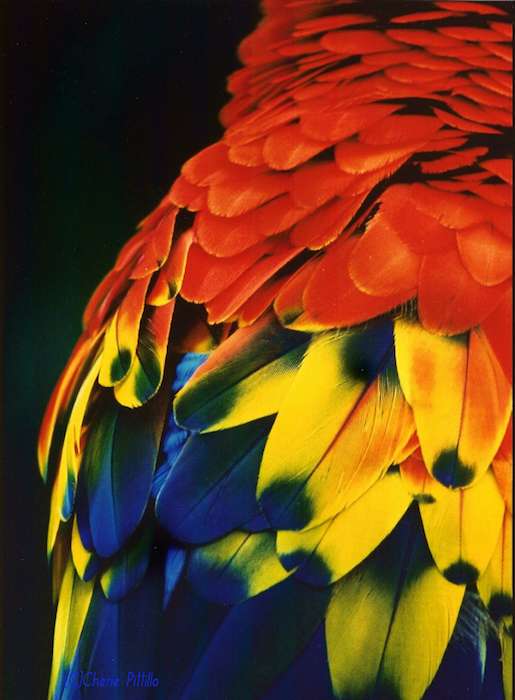Surely those vivid red and yellow feathers of the Scarlet Macaw are produced by carotenoid pigments which produce red, yellow and orange feathers.
Nope.

All parrots use five psittacin (“citizen”) pigments, also called psittacofulvins, which are produced internally by the parrot. These pigments do not come from their diet. According to research, these unique pigments only occur in parrots! Hues are similar to the carotenoids but reds are more enhanced.

For years scientists studied parrot pigments as sexual attractants rather than their chemical composition. They studied red feathers of different ages and sexes of true parrots, lories, and cockatoos and the concentration of psittacins varied significantly.


Males had more pigments than females while lories had the highest concentrations. But surprise, surprise! No blood samples showed any psittacins but carotenoids. It seems parrots could use the carotenoids but don’t. Eureka! Whether parrots were in captivity or not, parrots synthesize psittacins in growing feathers and not the carotenoids.
So what about those green feathers in parrots or other birds? Green is not a true color pigment except in a group of African birds called the turaco. They actually produce a rare green pigment, turacoverdin, from copper atoms.
Green feathers are typically referred to as structural colors. They are produced when light hits those tiny feather parts and those melanin grains (discussed in part 1) work together to refract light. Of course, sometimes yellow (carotenoid) pigments can mix with blue structural colors too. Or parrots can use their yellow psittacin pigment and the structural color blue to produce green.
PHOTO5 Did this female Green Honeycreeper just realize it lacked green feather pigments?


Blue? I’ve not mentioned blue pigments in birds because they don’t exist. WHAT????
Whether it’s an Ocellated Turkey, Indigo Bunting, Blue Grosbeak, Scrub Jay, Blue Jay, or other birds with blue feathers or skin in your neighborhood, they all lack blue pigments.




Let me now explain yet another pigment of your imagination.
Remember the acronym for rainbow colors, Roy G. Biv? Those blue/indigo/violet colors (and purple) are shorter wavelengths of light than the red end. They reflect easier than other colors and may reduce the visibility of other colors.
Certain birds have a spongy layer in their feather structure with similar-sized air pockets and channels. They are evenly distributed and make a pattern. This pattern matches the wavelength of blue light. When light hits those structures, it bends the light waves and you see blue.
PHOTO12 Does the Blue Jay ponder why it really doesn’t have blue pigments?
Still don’t believe your eyes? If you pick up a blue feather and look at the back of it, you won’t see a blue color. Or look at these two images of a Hyacinth Macaw. Do you see any blue on the back of their wing feathers?


This phenomenon, called Tyndall Scattering, also explains why we see the sky as blue. Very small particles scatter the shorter wavelengths in visible or white light. You’re welcome to google that term to understand the physics. As for me, my job is done for now. And I hope you’ve learned more about real pigments and pigments of imagination!
GO COLOR YOUR WORLD IN NATURE!
STAY TUNED NEXT MONTH FOR A SPECIAL 10TH ANNIVERSARY EDITION OF BACKYARD BIRDING!
SPECIES LIST:
Scarlet Macaw, Ara macao, Guacamaya Roja (Spanish)
Red-and-green Macaw, Ara chloropterus, Guacamaya Roja y Verde (Spanish)
*Green Honeycreeper, Chlorophanes spiza, Mielero Verde (Spanish)
*Monk Parakeet, Myiositta monachus, Perico Monje Argento (Spanish)
*White-fronted Parrot, Amazon albifrons, Loro Frente Blanca, Sak pool xt’uut (Mayan)
*Ocellated Turkey, Meleagris ocellata, Guajolote Ocelado (Spanish), Kuuts (Mayan)
*Indigo Bunting, Passerina cyanea, Colorin Azul (Spanish)
*Blue Grosbeak, Passerina caerulea, Picogordo Azul (Spanish)
Florida Scrub-Jay, Aphelocoma coerulescens, Chara Floridana (Spanish)
Blue Jay, Cyanocitta cristata, Chara Azul (Spanish)
Hyacinth Macaw, Anodorhynchus hyacinthinus, Guacamaya Jacinto (Spanish)
*Occur in Yucatan Peninsula excluding captive species
Link to Part 1 https://www.theyucatantimes.com/2021/08/backyard-birding-in-merida-yucatan-and-beyond-pigments-of-your-imagination-bird-plumage-part-1-of-3/
Link to Part 2 https://www.theyucatantimes.com/2021/09/backyard-birding-in-merida-yucatan-and-beyond-pigments-of-your-imagination-bird-plumage-glowing-owls-and-virginity-signals-part-2-of-3/
DISCLAIMER: References do not agree about this information.
Sal a Pajarear Yucatán, Birds & Reserves of the Yucatan Peninsula, A Guide to the Birds of Mexico and North Central America, The Handbook of Bird Biology, A Dictionary of Birds, The Sibley Guide to Birds, What It’s Like To Be A Bird
https://www.ncbi.nlm.nih.gov/pmc/articles/PMC1629064
https://pubmed.ncbi.nlm.nih.gov/15253871/
https://www.ncbi.nlm.nih.gov/pmc/articles/PMC1626226/
https://www.audubon.org/news/what-makes-bird-feathers-so-colorfully-fabulous
Cherie Pittillo, “nature-inspired,” photographer and author, explores nature everywhere she goes. She’s identified 56 bird species in her Merida, Yucatan backyard view. Her monthly column features anecdotes about birding in Merida, Yucatan, and also wildlife beyond the Yucatan.
Contact: [email protected] All rights reserved, ©Cherie Pittillo
